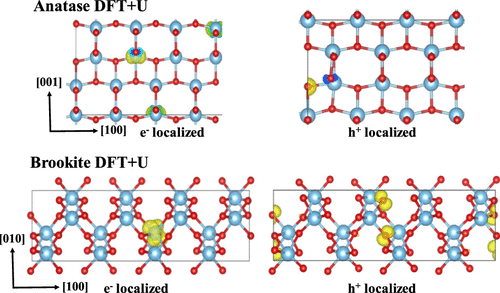Our official English website, www.x-mol.net, welcomes your
feedback! (Note: you will need to create a separate account there.)
Investigating Polaron Formation in Anatase and Brookite TiO2 by Density Functional Theory with Hybrid-Functional and DFT + U Methods
ACS Omega ( IF 3.7 ) Pub Date : 2019-05-02 00:00:00 , DOI: 10.1021/acsomega.9b00443 Jeffrey Roshan De Lile 1 , Sung Gu Kang 2 , Young-A Son 3 , Seung Geol Lee 1
ACS Omega ( IF 3.7 ) Pub Date : 2019-05-02 00:00:00 , DOI: 10.1021/acsomega.9b00443 Jeffrey Roshan De Lile 1 , Sung Gu Kang 2 , Young-A Son 3 , Seung Geol Lee 1
Affiliation

|
Anatase and brookite are robust materials with enhanced photocatalytic properties. In this study, we used density functional theory (DFT) with a hybrid functional and the Hubbard on-site potential methods to determine electron- and hole-polaron geometries for anatase and brookite and their energetics. Localized electron and hole polarons were predicted not to form in anatase using DFT with hybrid functionals. In contrast, brookite formed both electron and hole polarons. The brookite electron-polaronic solution exhibits coexisting localized and delocalized states, with hole polarons mainly dispersed on two-coordinated oxygen ions. Hubbard on-site potential testing over the wide 4.0–10 eV range revealed that brookite polarons are formed at U = 6 eV, while anatase polarons are formed at U = 8 eV. The brookite electron polaron was always localized on a single titanium ion under the Hubbard model, whereas the hole polaron was dispersed over four oxygen atoms, consistent with the hybrid DFT studies. The anatase electron polarons were dispersed at lower on-site potentials but were more localized at higher potentials. Both methods predict that brookite has a higher driving force for the formation of polarons than anatase.
中文翻译:

混合-密度泛函理论和DFT + U法研究锐钛矿和锐钛矿型TiO 2中的极化子形成
锐钛矿和板钛矿是具有增强的光催化性能的坚固材料。在这项研究中,我们使用具有混合功能的密度泛函理论(DFT)和Hubbard现场电势方法来确定锐钛矿和板钛矿及其能量学的电子和空穴极化子几何形状。使用具有混合功能的DFT,可以预测在锐钛矿中不会形成局部电子和空穴极化子。相反,板钛矿既形成电子极化子,又形成空穴极化子。板钛矿电子极化溶液具有局域和局域共存的状态,空穴极化子主要分散在两个配位的氧离子上。Hubbard在4.0–10 eV宽范围内进行的现场电势测试表明,在U = 6 eV处形成了板钛矿极化子,而在U处形成了锐钛矿极化子。= 8 eV。在Hubbard模型下,板钛矿电子极化子始终位于单个钛离子上,而空穴极化子则分散在四个氧原子上,这与混合DFT研究一致。锐钛矿型电子极化子分散在较低的现场电势,但更多地定位在较高的电势。两种方法都预测板钛矿比起锐钛矿具有更高的形成极化子的驱动力。
更新日期:2019-05-02
中文翻译:

混合-密度泛函理论和DFT + U法研究锐钛矿和锐钛矿型TiO 2中的极化子形成
锐钛矿和板钛矿是具有增强的光催化性能的坚固材料。在这项研究中,我们使用具有混合功能的密度泛函理论(DFT)和Hubbard现场电势方法来确定锐钛矿和板钛矿及其能量学的电子和空穴极化子几何形状。使用具有混合功能的DFT,可以预测在锐钛矿中不会形成局部电子和空穴极化子。相反,板钛矿既形成电子极化子,又形成空穴极化子。板钛矿电子极化溶液具有局域和局域共存的状态,空穴极化子主要分散在两个配位的氧离子上。Hubbard在4.0–10 eV宽范围内进行的现场电势测试表明,在U = 6 eV处形成了板钛矿极化子,而在U处形成了锐钛矿极化子。= 8 eV。在Hubbard模型下,板钛矿电子极化子始终位于单个钛离子上,而空穴极化子则分散在四个氧原子上,这与混合DFT研究一致。锐钛矿型电子极化子分散在较低的现场电势,但更多地定位在较高的电势。两种方法都预测板钛矿比起锐钛矿具有更高的形成极化子的驱动力。






























 京公网安备 11010802027423号
京公网安备 11010802027423号